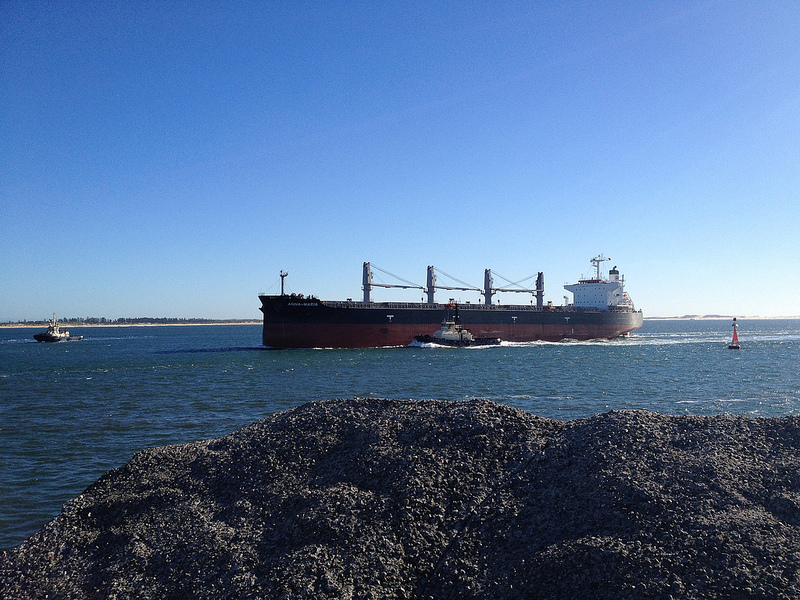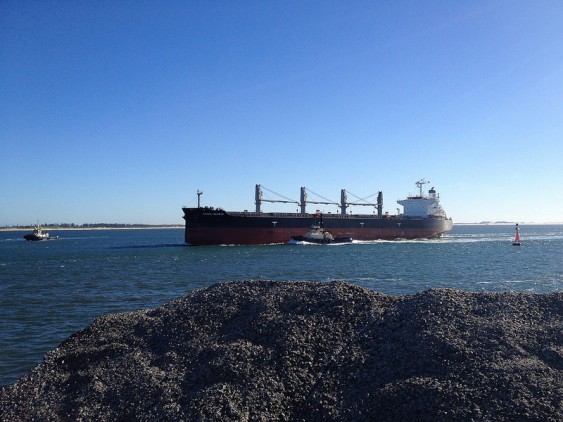Hot off the presses: the three “co-lead” agencies in charge of reviewing the proposed Gateway Pacific coal export terminal at Cherry Point, Washington have published the scope of their review. The major takeaway is that it’s bad news for the coal industry.
The industry did win an empty victory with the Army Corps of Engineers, the sole federal agency at the table, which opted for a narrow scope of review. But in the end it doesn’t much matter. One of the other lead agencies, the Washington Department of Ecology, is going to require in-depth analysis of four elements that the coal industry had desperately hoped to avoid:
- A detailed assessment of rail transportation on other representative communities in Washington and a general analysis of out-of-state rail impacts.
- An assessment of how the project would affect human health in Washington.
- A general assessment of cargo-ship impacts beyond Washington waters.
- An evaluation and disclosure of greenhouse gas emissions of end-use coal combustion.
Of those, two stand to be particularly damaging for would-be coal exporters: rail impacts and greenhouse gas emissions. There’s not a lot of wiggle room with either of those elements.
First, burning the 48 million tons of coal proposed for export at the terminal annually would release roughly 100 million tons of carbon dioxide, a staggering figure that amounts to as much carbon pollution as every activity in the state of Washington combined. In other words, it’s a clear environmental disaster that would overshadow every other effort the state has made to reduce climate-changing emissions.
Second, moving that much coal to a terminal will create congestion throughout the region. There’s simply no way around the math. In Seattle, for example, both Sightline and the traffic analysis firm Parametrix have confirmed that new coal export shipments would completely close major center city streets by an additional 1 to 3 hours every day, 365 days per year. (Sightline analysis here; Parametrix here.)
What’s worse for the coal industry, is that the expansive scope of review will likely create further delay and uncertainty, potentially scaring off investors. Just yesterday, in fact, in a sad sack discussion of its second quarter earnings, Cloud Peak executives griped about the slow progress on coal export terminals:
They did flag though unfortunately because of opponent’s abilities to protest everything then the things don’t go any faster, they tend to go slower… We’re thinking like 2018 for Gateway Pacific, I think is what we got at the moment, but it will be what it’ll be, but I think the next thing to wait for is the scope of the [E]IS and then we’ll need that work to be done which takes a couple of years.
Now that public agencies will be tallying the manifest pollution, health, climate, and congestion impacts of Gateway Pacific coal terminal, there’s likely to be even more opposition as the potential impacts become more widely understood. Plus, given more analysis and a wider exploration of the proposal’s problems, opponents will likely find abundant opportunities to litigate, which would of course create even more delay and uncertainty.
So for the proposed Gateway Pacific coal terminal, the bottom line of today’s announcement is: long delays, high costs, more opportunities for public opposition, and a near-certainty of litigation. Coupled with the ongoing collapse in Pacific Rim coal prices, it’s not a fun time to be in the Northwest coal export business.











J C Bettencourt
Well, this is good, interesting news. Many of us in Oregon are fighting to keep coal trains off of rail tracks that run through some of our most pristine areas, as well as through the middle middle of some of our towns and cities. We don’t want dirty coal spilling onto our lands, near our schools and downtowns and snarling traffic. We fear the highly combustible nature of coal and don’t want it loaded into barges in the Columbia River basin. We are also against the burning of coal, which produces such toxic emissions. We hope our Dept. of Environmental Quality and our governor have been listening to our pleas to keep coal trains out of the NW!
TerryWechsler
Haven’t had time to review the announcements yet. Is anyone talking about an economic impacts assessment?
And, JC, good luck in Oregon!
Don
I wonder if Washington State will require the same assessment for crude oil transfers for Washington ports?
Toni
We have at least 6 coal trains a day passing through our state dropping tons of coal. This has change my life as I live right on the rail line. My allergies are increased, I lost a tree, the rest of my plants are coated, my koi pond is suffering, i have evidence of acid rain on my concrete block patio, my house has black soot on it that i wash with simple green and a brush and my driveway is black from coal and diesel. This is happening right now wherever coal travels.
I am thrilled that our hard work has paid off for CherryPoint but want these coal trains to Canada stopped now. We are going to have rail impacts studied to see if we want coal in our state and yet, there goes another coal train.
At the hearing in Vancouver the Railroad made it’s usual threat ” We will ship coal through you even if you deny these ports.” They are doing that right now.
The devastation we saw along the Columbia River with piles of coal is now, we don’t need to study what would happen but what is happening.
Congestion on the tracks has already kept a fire truck from cross to get to a fire. This is now folks.
I live by a Chum Salmon spawning ground, one of three left on the lower Columbia, the trains go right over it’s water supply. I helped save it and worry over this endangered salmon.
We are in this fight today, it is now and we need to stop it and let Canada figure out another route through their own country if they want this polluting industry in their Port.
Sandy
This is wonderful news, giving the Pacific Northwest hope that we will not be destroyed.
Hopefully, the same studies will be done for the oil trains and their potential for disaster. The product they carry is bad enough, but coupled with the weak cars, make a disaster a reality, not a potential.
The weight of the coal cars presently passing is destroying the integrity of the rails; the spillage from the 6 coal trains a day weaken the rails. BNSF is x-raying the rails every 28 days, according to one of the workers I spoke with on Saturday, to prevent derailments!
We live on the Columbia River, at a chum salmon spawning site.
The coal dust is polluting the wetlands beside the rail, the marsh across the road; the creek they feed enters the Columbia River in a matter of a few short feet. The Federally endangered chum salmon spawn there, as do the spring, summer, fall, and winter steelhead.
Our property title is written with environmental protection for perpetuity, but we cannot keep the coal out of the water and land.
Allowing coal trains to pass is jeopardizing the spawning sites.
Why are we permitting them to pass; most of the coal is for Canada, and they should bear the burden of the transport. We are closing coal power plants; so should they!
Eldon Jacobson
Good scientists look at all the facts, which I expect this review to to.
Fact: China is going to buy coal, if not from US, from another country. One article I saw previously indicated the coal from US is better for the environment compared to the dirtier coal from other parts of the world. More analysis of this is needed.
Fact: The City of Seattle has cancelled plans for two locations that would have built bridges over the tracks (S. Lander St. and Broad St.). In case anybody has noticed, Sound Transit has been adding trains to the tracks, which block the roads crossing the tracks, just like the coal trains (though the coal trains are longer).
Fact: The City of Edmonds canceled plans to relocate the Ferry Terminal and build a bridge over the railroad tracks. Looks like a pretty poor decision, now.
Jackie
China plans to end importation asap.by increasing their coal mining capabilities.
Cities (taxpayers) can’t afford to build bridges for coal industry profits…there is nothing in it for residents or the city.
Steve Erickson
If the external costs of coal – pollution, health and traffic impacts – are internalized into its cost, than it will cost more. f it costs more, less will be consumed and alternatives such as efficiency, conservation, and alternatives will be used. So, coal consumption is decreased by the PNW refusing to be a resource shipping route for the benefit of Peabody Coal, BNSF, SSA Marine, Goldman Sachs, and Warren Bufffet. And that’s good.
MFKJ
The economic benefit of coal is all the coal people have left to talk about. The reality is the jobs are few, many temporary and in no way justify the environmental damage coal produces. It’s as if the tobacco industry were touting the number of jobs that would be lost when smoking became illegal in restaurants and bars. The economic damage to the industry has been insignificant to the health benefits to the population as a whole. Money really isn’t the only thing.
Charles Carver
The expansion of the scope of the impacts of coal transport and emissions is a remarkable development and very heartening. This a great opportunity to expose how corporations privatize profits and socialize the costs. Of course they are not happy with the delay. Our communities will have time to educate themselves about all of this and discover what many of us already know: that the hidden costs of coal mining, transport and burning far outweigh the economic benefits and most of those benefits end up in corporate coffers. It really is a time to turn our focus to creating a new energy economy, hopefully one more ecologically sensitive, egalitarian and decentralized to serve an increasingly ecologically conscious populace.
Norm Cimon
Eric, I believe that the impact from the coal dust will be very significant. By my calculation, taken from BNSF’s own numbers, between 500,000 and 1.1 million tons of coal dust will be lost just on the portion of the route from Coeur D’Alene, ID across the Basin. That’s from the 34 trains each with 125 cars every day that would traverse at full buildout. By that I mean if the plans that have been filed for port facilities ever come to complete fruition. Those plans call for 170 million tons of coal/year, all of it travelling through the Columbia Basin.
Everyone who lives in the Basin or who’s spent any time there in the winter knows that inversions can dominate for weeks on end. Much of the coal would be entrained into that layer and remain trapped, gradually diffusing throughout that entire basin-filling cloud. The people, the towns, the agriculture, the server farms with their need for clean air… all of it would be impacted. Again, at full buildout, every twelve seconds there would be a coal car being unloaded somewhere. One more time: at full buildout there would, at any given instant, be 6 or 7 125-car trains in the Columbia Basin. That’s the only way you can get 34 fully loaded trains from Wyoming or Montana through every day. You have to keep them running constantly. For all practical purposes, this represents a near-continuous stream of coal dust.
I don’t believe the straightforward logistics of this have been fully understood.